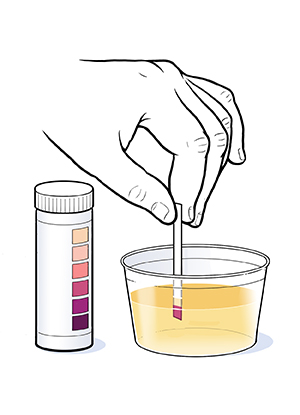Discharge Instructions: Checking for Ketones
Discharge Instructions: Checking for Ketones
The body needs glucose (a kind of sugar from food) for energy. If it doesn’t get the glucose it needs, it starts burning fat. When fat is burned it produces ketones. Ketones can build up in the blood and urine. This buildup can cause a dangerous condition called ketoacidosis. It’s for this reason that you should check for ketones at times when you are most at risk.
When to check for ketones
Check for ketones, especially if you have type 1 diabetes, when any of the following is true:
Your blood sugar is above 250 mg/dL (milligrams per deciliter).
You are ill or under stress.
You have diarrhea (loose stool) or stomach pain.
You are very thirsty or need to urinate often.
You have a dry mouth or if your breath smells "fruity."
You feel sick or nauseated, or you have vomited and are becoming dehydrated.
You have run out of your usual diabetes medicines and cannot obtain them promptly (especially if you have been using insulin).
How to check for ketones
Suggestions for checking for ketones include the following:
Check for ketones by using testing tablets or strips. Different types of test kits are available from your local pharmacy.
Depending on the type of test you buy, you can check for ketones in your urine or in your blood.
Record your test results in a notebook so that you can show them to your healthcare provider.
Contact your healthcare provider if you test positive for ketones. If your sick day guidelines tell you what to do in the presence of high glucose and ketones, follow the instructions.
Urine tests
Tips for using urine tests include the following:
Follow the package directions carefully.
Use a clean container (one washed with soap and water) to get a sample of your urine.
Place the test strip in the urine sample or pass the strip through your urine stream.
Gently shake excess urine off the strip.
Wait for the strip to change color. The directions will tell you how long to wait.
Compare the strip with the color chart on the bottle or package. This gives you a range for the number of ketones in your urine.
Record your results.
Blood tests
Tips for testing your blood include the following:
Use the meter and blood ketone strips as directed by your healthcare provider
Record your results.
To learn more
The resources below can help you learn more:
American Diabetes Association 800-342-2383 www.diabetes.org
Hormone Health Network 800-467-6663 www.hormone.org
Follow-up
Make a follow-up appointment as directed by your healthcare provider.
When to call your healthcare provider
Call your healthcare provider right away if you have any of the following:
Fever of 100.4°F (38°C) or higher
Fatigue
Dry or flushed skin
Nausea or vomiting
Stomach pain
Shallow breathing
A sweet, fruity odor on your breath
Confusion
If your urine shows moderate to large amounts of ketones
Updated:
April 20, 2018
Sources:
Management of Hyperglycemia in Type 2 Diabetes: A Patient-Centered Approach. Inzucchi S. Diabetes Care. 2012;35:1364-79.
Reviewed By:
Hurd, Robert, MD,Image reviewed by StayWell medical illustration team.,Sather, Rita, RN
